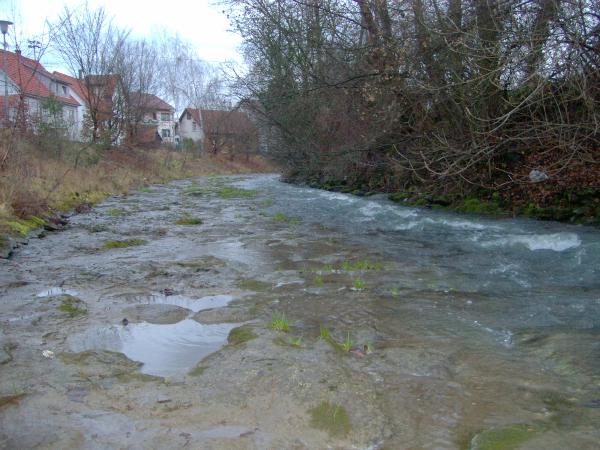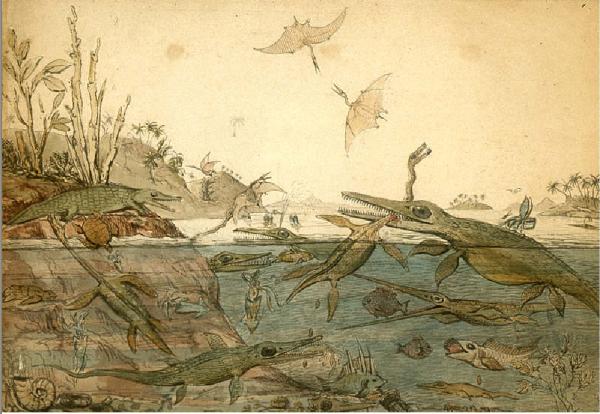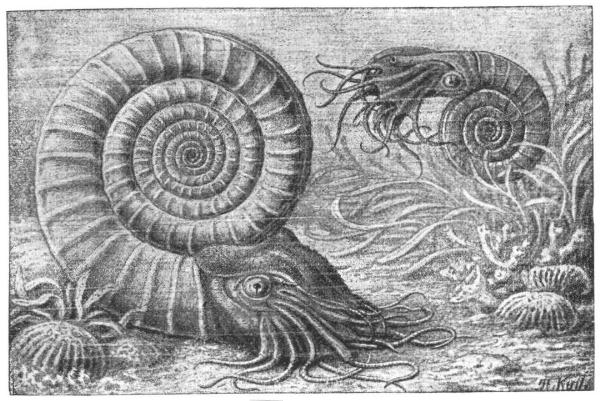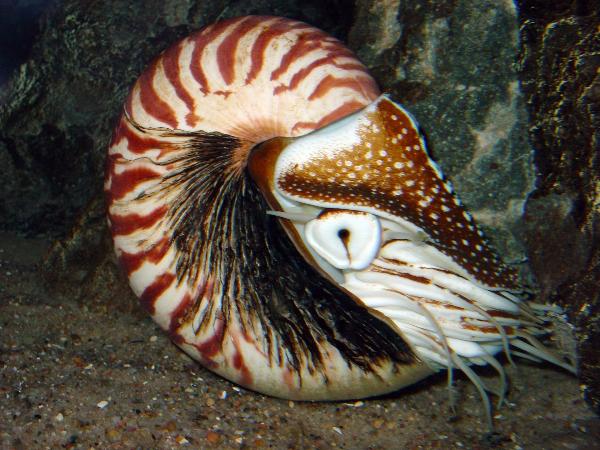

 Am südlichen Ortsrand von Ofterdingen hat die Steinlach, die am Albtrauf bei Talheim (heute zu Mössingen) entspringt und in Tübingen in den Neckar mündet auf etwa 500m Länge eine Felsplatte freigespült. Diese gehört zur Schichtstufe des Schwarzen Jura (Lias) α, die das Vorland der Schwäbischen Alb bildet. Sie trägt wie eine Reliefskulptur die Steinkerne von verschiedenen Fossilien, insbesondere von Ammoniten der Gattung Arietites mit ihren kräftig gerippten, bis zu 1m Durchmesser großen Gehäusen, ferner einzelne Steinkerne des Nautilus giganteus und viele Schalenreste einer stark gewölbten Austernmuschel (Gryphaea arcuata). Die dicken, blauschwarzen Arietenkalke, auch „Gryphaeen-“ oder „Arkuatenkalke“ genannt, schließen den Schwarzen Jura α nach oben hin ab.
Am südlichen Ortsrand von Ofterdingen hat die Steinlach, die am Albtrauf bei Talheim (heute zu Mössingen) entspringt und in Tübingen in den Neckar mündet auf etwa 500m Länge eine Felsplatte freigespült. Diese gehört zur Schichtstufe des Schwarzen Jura (Lias) α, die das Vorland der Schwäbischen Alb bildet. Sie trägt wie eine Reliefskulptur die Steinkerne von verschiedenen Fossilien, insbesondere von Ammoniten der Gattung Arietites mit ihren kräftig gerippten, bis zu 1m Durchmesser großen Gehäusen, ferner einzelne Steinkerne des Nautilus giganteus und viele Schalenreste einer stark gewölbten Austernmuschel (Gryphaea arcuata). Die dicken, blauschwarzen Arietenkalke, auch „Gryphaeen-“ oder „Arkuatenkalke“ genannt, schließen den Schwarzen Jura α nach oben hin ab.
Die Fossilien sind Zeugen eines Lebens vor ca. 180 Mill. Jahren im flachen Binnenmeer der Liaszeit. Aufgrund ihres reichen Vorkommens muss auf einen nahen Verlauf der ehemaligen Küstenlinie geschlossen werden. Die Schalen toter Tiere wurden von den Strömungen dorthin verfrachtet, eingebettet und versteinert. Vor 65 Mill. Jahren starben die Ammoniten aus. Die einzige überlebende Familie ist die der heute im Pazifik beheimateten Nautilus.
 Die Steinlach fließt über die Ammonitenschicht, daher die Bezeichnung „Ammonitenpflaster“, im Volksmund „Schneckenpflaster“. Schon Goethe hat auf seiner Reise in die Schweiz 1797 diese Felsbank besichtigt. Seit 1937 steht das „Schneckenpflaster“ als Naturdenkmal unter Schutz: Klopfen nicht gestattet!
Die Steinlach fließt über die Ammonitenschicht, daher die Bezeichnung „Ammonitenpflaster“, im Volksmund „Schneckenpflaster“. Schon Goethe hat auf seiner Reise in die Schweiz 1797 diese Felsbank besichtigt. Seit 1937 steht das „Schneckenpflaster“ als Naturdenkmal unter Schutz: Klopfen nicht gestattet!
Quelle:
„Meyers Naturführer Baden-Württemberg“
Meyers Lexikonverlag Mannheim/Wien/Zürich von Dr. Adolf Hanle 1989 S.264
Um diesen Cache loggen zu dürfen, musst du folgende Aufgaben erledigen:
Geht die Stufen in das Steinlachbachbett und sucht euch einen schönen großen Ammoniten aus. Macht ein Bild von euch und / oder eurem GPS mit dieser Versteinerung und fügt dieses Bild eurem Log zu. An den Listingkoordinaten findet ihr ein Schild. Dieses wird dir helfen die Fragen zu beantworten. Bitte sende eine Mail an Antwort1Antwort2Antwort3@gmail.com. Ihr bekommt in den nächsten Minuten eine Antwort mit der Logfreigabe. Falls nicht sendet bitte eine Mail an mein Profil.
Fragen:
1. „Als die des Schwarzen Juras vor 160 Millionen Jahren abgelagert wurde...“ Welches Wort fehlt?
2. Auf welchen Gott geht das Wort Ammoniten zurück?
3. Welcher Gattung gehören die Wesen an, die die Steinlach bei Ofterdingen freigelegt hat?


 The origin of the Steinlach brooklet is on the edge of the swabian alb, near the village Talheim. They join together with the river Neckar near Tübingen. Close to the town Ofterdingen stone layers can be seen. It is a jurassic period riverbed. It shows like a sculpture the different petrified fossils such as ammonites of the genus Arietites. They have dominant ribbed shells, up to the size of 1m diameter. You can find also fossils of the Nautilus giganteus and many shells from Gryphaea arcuata. These Arietites limes are blueblack in color and form the most recent layers of the lias.
The origin of the Steinlach brooklet is on the edge of the swabian alb, near the village Talheim. They join together with the river Neckar near Tübingen. Close to the town Ofterdingen stone layers can be seen. It is a jurassic period riverbed. It shows like a sculpture the different petrified fossils such as ammonites of the genus Arietites. They have dominant ribbed shells, up to the size of 1m diameter. You can find also fossils of the Nautilus giganteus and many shells from Gryphaea arcuata. These Arietites limes are blueblack in color and form the most recent layers of the lias.
These fossils lived 180 million years ago in a flat inland sea of the lias time. Because they appear so often, the coast must have been very close. The shells of the dead animals where carried by seas current, embedded and petrified. 65 million years ago the ammonites become extinct. The sole extant family of suborder Nautilina is the Nautilus, living in the pacific ocean.
The Steinlach brooklet flows over the ammonite layer, that is why it has the descripion „Ammonitenpflaster“ („ammonites cobbles“), popularily known as „Schneckenpflaster“ („snail cobbles“). Goethe visited this natural monument in 1797 during a trip to Switzerland. Since 1937 this „Schneckenpflaster“ is a protected natural phenomenon. The excavation of fossils is forbidden.
Source:
„Meyers Naturführer Baden-Württemberg“
Meyrs Lexikonverlag Mannheim/Wien/Zürich from Dr. Adolf Hanle 1989 p.264
In order to log this cache you must do the following:
Go down the stair to the Steinlach streambed and search a big and beautiful fossil of an ammonite. Take a picture with you and / or your GPS with that ammonite and add this picture to your log entry. At the listing coordinates you can find a sign. If you read those, you should be able to answer the questions without any problems. Please send a mail to Answer1Answer2Answer3@gmail.com. You immediately get an answer with the log release. If not send a mail to my profile.
Questions:
1. „Als die des Schwarzen Juras vor 160 Millionen Jahren abgelagert wurde...“ Which word is missing?
2. Which deity is responsible for the word Ammonite?
3. From which genus are the creatures you will find in the Steinlach brooklet in Ofterdingen?